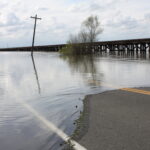Restored salmon habitat on the Stanislaus River
Entitled “Replenishing a River: Stanislaus River Honolulu Bar Restoration,” this 11-minute video uses underwater photography, still images and narration to illustrate an important project for restored salmon habitat that was completed in 2012. The Oakdale Irrigation District and U.S. Fish and Wildlife Service split the cost of the $1.1 million project. The work was done over two years by the biologists, engineers and technicians at FISHBIO.
Addressing the steep decline in salmon and steelhead trout populations in Central Valley waterways has been a shared priority of government officials, environmentalists and local water agencies for decades. Fall run Chinook salmon are listed as species of concern by California Department of Fish and Wildlife and steelhead are listed as a threatened species under the federal Endangered Species Act.
Diminished habitat key factor in population decline
Historically, tens of thousands of salmon returned to the Stanislaus River to spawn each year. In contrast, only about 6,000 returned this year. Diminished habitat in the river is a key factor in the decline.

The Honolulu Bar project focused on a 2½-acre site that was part of a larger gravel dredge bar in the river about halfway between Oakdale and Knights Ferry in northeastern Stanislaus County. The intent was to restore and, in some cases, create vital habitat for adults to spawn and juvenile fish to thrive until they begin their journey downstream through the Delta and San Francisco Bay to the Pacific Ocean.
Balanced approach protects farms and the environment
“I think we have to recognize that all these things – water, the resources they provide, the fish, the farming – we all have to live together in a healthy manner. You cannot use river assets and then not work to protect those river assets,” said Steve Knell, general manager of the OID.

